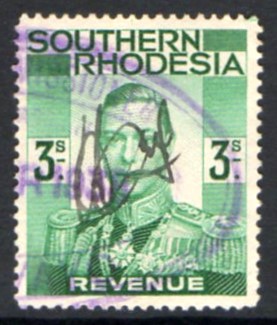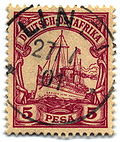
An overprint is an additional layer of text or graphics added to the face of a postage or revenue stamp, postal stationery, banknote or ticket after it has been printed. Post offices most often use overprints for internal administrative purposes such as accounting but they are also employed in public mail. Well-recognized varieties include commemorative overprints which are produced for their public appeal and command significant interest in the field of philately.
East Africa and Uganda Protectorates was the name used by the combined postal service of the British protectorates, British East Africa and Uganda, between 1 April 1903 and 22 July 1920.
This is a survey of the postage stamps and postal history of Tanganyika under British mandate.
This is a survey of the postage stamps and postal history of British East Africa.

The British Central Africa Protectorate existed in the area of present-day Malawi between 1891 and 1907.

Ubangi-Shari was a French colony in central Africa which later became the independent country of the Central African Republic on August 13, 1960. It followed the establishment of the Bangui outpost in 1889, and was named in 1894.
Each "article" in this category is in fact a collection of entries about several stamp issuers, presented in alphabetical order. The entries themselves are formulated on the micro model and so provide summary information about all known issuers.
Each "article" in this category is in fact a collection of entries about several stamp issuers, presented in alphabetical order. The entries themselves are formulated on the micro model and so provide summary information about all known issuers.
This is a survey of the postage stamps and postal history of Macau.

The Yacht issue was a series of postage stamps, bearing the image of German Kaiser's yacht, SMY Hohenzollern II, that were used in all of Germany's overseas colonies. Millions of stamps were produced and they were the principal means of postage for all German imperial overseas possessions in the years 1900–1915. German colonies at that time were German Samoa, Kiautschou Bay, Togoland, Kamerun, German New Guinea, German South-West Africa, and German East Africa.

This is a survey of postage stamps and postal history of the German colonies and part of the postage stamps and postal history of Germany, as well as those of the individual countries and territories concerned.

Belgium began using national postage stamps on 8 July 1849, when two imperforate stamps, a 10c. brown and 20c. blue, collectively known as Epaulettes, were introduced. A few months later a 40c. red stamp with a new design was issued, for postage to foreign destinations. In 1850 two new stamps of 10c. and 20c. were issued.

Burundi has issued postage stamps for national use since achieving independence on 1 July 1962. The country was formerly a part of the Belgian territory of Ruanda-Urundi and before 1962 used those postage stamps.
This is a survey of the postage stamps and postal history of the Democratic Republic of the Congo, formerly Zaire and the Belgian Congo.

This is a survey of the postage stamps and postal history of Rwanda. The Republic of Rwanda is a landlocked country located in the Great Lakes region of eastern-central Africa, bordered by Uganda, Burundi, the Democratic Republic of the Congo and Tanzania.

This is a survey of the postage stamps and postal history of Zanzibar.

The African territories of Ruanda and Urundi came under Belgian control as Ruanda-Urundi after they were seized from Germany during World War I in 1916. They had previously formed part of German East Africa.

Kenya, formerly known as British East Africa issued revenue stamps since 1891. There were numerous types of revenue stamps for a variety of taxes and fees. Also valid for fiscal use in Kenya were postage stamps issued by the following entities:

Nyasaland, now known as Malawi, first issued revenue stamps as British Central Africa in 1891 and continued to do so until the late 1980s.

Rhodesia, now divided between Zambia and Zimbabwe, first issued revenue stamps in 1890, and Zimbabwe continues to do so to this day.


















